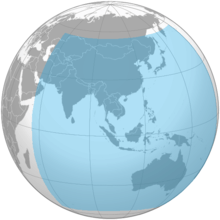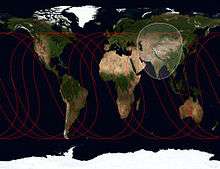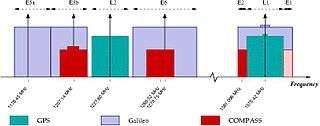BeiDou Navigation Satellite System
|
The BeiDou system's logo | |
| Country of origin | China |
|---|---|
| Operator(s) | CNSA |
| Type | Military, commercial |
| Status | Operational (regionally) |
| Coverage | Global |
| Precision |
10 m (public) 0.1 m (encrypted)[1] |
| Constellation size | |
| Total satellites | 35 |
| Satellites in orbit | 21 |
| First launch | 30 October 2000 (15 years ago) |
| Last launch | 12 June 2016 |
| Total launches | 27 |
| Orbital characteristics | |
| Regime(s) | GEO, IGSO, MEO |
| Geodesy | ||||||||||||||||
|---|---|---|---|---|---|---|---|---|---|---|---|---|---|---|---|---|
 | ||||||||||||||||
| Fundamentals | ||||||||||||||||
| Concepts | ||||||||||||||||
| Technologies | ||||||||||||||||
| Standards | ||||||||||||||||
|
||||||||||||||||
| History | ||||||||||||||||
The BeiDou Navigation Satellite System (BDS, simplified Chinese: 北斗卫星导航系统; traditional Chinese: 北斗衛星導航系統; pinyin: Běidǒu wèixīng dǎoháng xìtǒng) is a Chinese satellite navigation system. It consists of two separate satellite constellations – a limited test system that has been operating since 2000, and a full-scale global navigation system that is currently under construction.
The first BeiDou system, officially called the BeiDou Satellite Navigation Experimental System (simplified Chinese: 北斗卫星导航试验系统; traditional Chinese: 北斗衛星導航試驗系統; pinyin: Běidǒu wèixīng dǎoháng shìyàn xìtǒng) and also known as BeiDou-1, consists of three satellites and offers limited coverage and applications. It has been offering navigation services, mainly for customers in China and neighboring regions, since 2000.
The second generation of the system, officially called the BeiDou Navigation Satellite System (BDS) and also known as COMPASS or BeiDou-2, will be a global satellite navigation system consisting of 35 satellites, and is under construction as of January 2015. It became operational in China in December 2011, with 10 satellites in use,[2] and began offering services to customers in the Asia-Pacific region in December 2012.[3] It is planned to begin serving global customers upon its completion in 2020.
In-mid 2015, China started the build-up of the third generation BeiDou system (BDS-3) in the global coverage constellation. The first BDS-3 satellite was launched 30 September 2015.[4] As of March 2016, 4 BDS-3 in-orbit validation satellites have been launched.[5]
According to China Daily, fifteen years after the satellite system was launched, it is now generating a turnover of $31.5 billion per annum for major companies such as China Aerospace Science and Industry Corp, AutoNavi Holdings Ltd, and China North Industries Group Corp.[6]
Nomenclature
The official English name of the system is BeiDou Navigation Satellite System.[7] It is named after the Big Dipper constellation, which is known in Chinese as Běidǒu. The name literally means "Northern Dipper", the name given by ancient Chinese astronomers to the seven brightest stars of the Ursa Major constellation.[8] Historically, this set of stars was used in navigation to locate the North Star Polaris. As such, the name BeiDou also serves as a metaphor for the purpose of the satellite navigation system.
History
Conception and initial development
The original idea of a Chinese satellite navigation system was conceived by Chen Fangyun and his colleagues in the 1980s.[9] According to the China National Space Administration, the development of the system would be carried out in three steps:[10]
- 2000–2003: experimental BeiDou navigation system consisting of 3 satellites
- by 2012: regional BeiDou navigation system covering China and neighboring regions
- by 2020: global BeiDou navigation system
The first satellite, BeiDou-1A, was launched on 30 October 2000, followed by BeiDou-1B on 20 December 2000. The third satellite, BeiDou-1C (a backup satellite), was put into orbit on 25 May 2003.[11][12] The successful launch of BeiDou-1C also meant the establishment of the BeiDou-1 navigation system.
On 2 November 2006, China announced that from 2008 BeiDou would offer an open service with an accuracy of 10 meters, timing of 0.2 microseconds, and speed of 0.2 meters/second.[13]
In February 2007, the fourth and last satellite of the BeiDou-1 system, BeiDou-1D (sometimes called BeiDou-2A, serving as a backup satellite), was sent up into space.[14] It was reported that the satellite had suffered from a control system malfunction but was then fully restored.[15][16]
In April 2007, the first satellite of BeiDou-2, namely Compass-M1 (to validate frequencies for the BeiDou-2 constellation) was successfully put into its working orbit. The second BeiDou-2 constellation satellite Compass-G2 was launched on 15 April 2009.[17] On 15 January 2010, the official website of the BeiDou Navigation Satellite System went online,[18] and the system's third satellite (Compass-G1) was carried into its orbit by a Long March 3C rocket on 17 January 2010.[18] On 2 June 2010, the fourth satellite was launched successfully into orbit.[19] The fifth orbiter was launched into space from Xichang Satellite Launch Center by an LM-3I carrier rocket on 1 August 2010.[20] Three months later, on 1 November 2010, the sixth satellite was sent into orbit by LM-3C.[21] Another satellite, the Beidou-2/Compass IGSO-5 (fifth inclined geosynchonous orbit) satellite, was launched from the Xichang Satellite Launch Center by a Long March-3A on 1 December 2011 (UTC).[22]
Chinese involvement in Galileo system
In September 2003, China intended to join the European Galileo positioning system project and was to invest €230 million (USD296 million, GBP160 million) in Galileo over the next few years.[23] At the time, it was believed that China's "BeiDou" navigation system would then only be used by its armed forces.[13] In October 2004, China officially joined the Galileo project by signing the Agreement on the Cooperation in the Galileo Program between the "Galileo Joint Undertaking" (GJU) and the "National Remote Sensing Centre of China" (NRSCC).[24] Based on the Sino-European Cooperation Agreement on Galileo program, China Galileo Industries (CGI), the prime contractor of the China’s involvement in Galileo programs, was founded in December 2004.[25] By April 2006, eleven cooperation projects within the Galileo framework had been signed between China and EU.[26] However, the Hong Kong-based South China Morning Post reported in January 2008 that China was unsatisfied with its role in the Galileo project and was to compete with Galileo in the Asian market.[27]
Phase III
- In November 2014, Beidou became part of the World-Wide Radionavigation System (WWRNS) at the 94th meeting of The International Maritime Organization (IMO) Maritime Safety Committee,[28] which approved the "Navigation Safety Circular" of the Beidou Navigation Satellite System (BDS).[29][30]
- At Beijing time 21:52, March 30, 2015, the first new-generation BeiDou Navigation satellite (and the 17th overall) was successfully set to orbit by a Long March 3C rocket.[31][32]
Experimental system (BeiDou-1)
Description

BeiDou-1 is an experimental regional navigation system, which consists of four satellites (three working satellites and one backup satellite). The satellites themselves were based on the Chinese DFH-3 geostationary communications satellite and had a launch weight of 1,000 kilograms (2,200 pounds) each.[33]
Unlike the American GPS, Russian GLONASS, and European Galileo systems, which use medium Earth orbit satellites, BeiDou-1 uses satellites in geostationary orbit. This means that the system does not require a large constellation of satellites, but it also limits the coverage to areas on Earth where the satellites are visible.[11] The area that can be serviced is from longitude 70°E to 140°E and from latitude 5°N to 55°N. A frequency of the system is 2491.75 MHz.[15]
Completion
The first satellite, BeiDou-1A, was launched on October 31, 2000. The second satellite, BeiDou-1B, was successfully launched on December 21, 2000. The last operational satellite of the constellation, BeiDou-1C, was launched on May 25, 2003.[11]
Position calculation
In 2007, the official Xinhua News Agency reported that the resolution of the BeiDou system was as high as 0.5 metres.[34] With the existing user terminals it appears that the calibrated accuracy is 20m (100m, uncalibrated).[35]
Terminals
In 2008, a BeiDou-1 ground terminal cost around CN¥ 20,000RMB (US$2,929), almost 10 times the price of a contemporary GPS terminal.[36] The price of the terminals was explained as being due to the cost of imported microchips.[37] At the China High-Tech Fair ELEXCON of November 2009 in Shenzhen, a BeiDou terminal priced at CN¥ 3,000RMB was presented.[38]
Applications
- Over 1,000 BeiDou-1 terminals were used after the 2008 Sichuan earthquake, providing information from the disaster area.[39]
- As of October 2009, all Chinese border guards in Yunnan are equipped with BeiDou-1 devices.[40]
According to Sun Jiadong, the chief designer of the navigation system, "Many organizations have been using our system for a while, and they like it very much."[41]
The new-generation BeiDou satellites support short message service.[32]
Global system (BeiDou Navigation Satellite System or BeiDou-2)
Description

BeiDou-2 (formerly known as COMPASS)[42] is not an extension to the older BeiDou-1, but rather supersedes it outright. The new system will be a constellation of 35 satellites, which include 5 geostationary orbit satellites for backward compatibility with BeiDou-1, and 30 non-geostationary satellites (27 in medium Earth orbit and 3 in inclined geosynchronous orbit),[43] that will offer complete coverage of the globe.
The ranging signals are based on the CDMA principle and have complex structure typical of Galileo or modernized GPS. Similar to the other global navigation satellite systems (GNSSs), there will be two levels of positioning service: open (public) and restricted (military). The public service will be available globally to general users. When all the currently planned GNSSs are deployed, users of multi-constellation receivers will benefit from a total over 100 satellites, which will significantly improve all aspects of positioning, especially availability of the signals in so-called urban canyons.[44] The general designer of the COMPASS navigation system is Sun Jiadong, who is also the general designer of its predecessor, the original BeiDou navigation system.
Accuracy
There are two levels of service provided — a free service to civilians and licensed service to the Chinese government and military.[19][45] The free civilian service has a 10-meter location-tracking accuracy, synchronizes clocks with an accuracy of 10 nanoseconds, and measures speeds to within 0.2 m/s. The restricted military service has a location accuracy of 10 centimetres,[46] can be used for communication, and will supply information about the system status to the user. To date, the military service has been granted only to the People's Liberation Army and to the Military of Pakistan.[47][48]
Frequencies
Frequencies for COMPASS are allocated in four bands: E1, E2, E5B, and E6 and overlap with Galileo. The fact of overlapping could be convenient from the point of view of the receiver design, but on the other hand raises the issues of inter-system interference, especially within E1 and E2 bands, which are allocated for Galileo's publicly regulated service.[49] However, under International Telecommunication Union (ITU) policies, the first nation to start broadcasting in a specific frequency will have priority to that frequency, and any subsequent users will be required to obtain permission prior to using that frequency, and otherwise ensure that their broadcasts do not interfere with the original nation's broadcasts. It now appears that Chinese COMPASS satellites will start transmitting in the E1, E2, E5B, and E6 bands before Europe's Galileo satellites and thus have primary rights to these frequency ranges.[50]
Although little was officially announced by Chinese authorities about the signals of the new system, the launch of the first COMPASS satellite permitted independent researchers not only to study general characteristics of the signals, but even to build a COMPASS receiver.
Compass-M1
Compass-M1 is an experimental satellite launched for signal testing and validation and for the frequency filing on 14 April 2007. The role of Compass-M1 for Compass is similar to the role of the GIOVE satellites for the Galileo system. The orbit of Compass-M1 is nearly circular, has an altitude of 21,150 km and an inclination of 55.5 degrees.
Compass-M1 transmits in 3 bands: E2, E5B, and E6. In each frequency band two coherent sub-signals have been detected with a phase shift of 90 degrees (in quadrature). These signal components are further referred to as "I" and "Q". The "I" components have shorter codes and are likely to be intended for the open service. The "Q" components have much longer codes, are more interference resistive, and are probably intended for the restricted service. IQ modulation has been the method in both wired and wireless digital modulation since morsetting carrier signal 100 years ago.
The investigation of the transmitted signals started immediately after the launch of Compass -M1 on 14 April 2007. Soon after in June 2007, engineers at CNES reported the spectrum and structure of the signals.[51] A month later, researchers from Stanford University reported the complete decoding of the “I” signals components.[52][53] The knowledge of the codes allowed a group of engineers at Septentrio to build the COMPASS receiver[54] and report tracking and multipath characteristics of the “I” signals on E2 and E5B.[55]
| Parameters | E2-I | E2-Q | E5B-I | E5B-Q | E6-I | E6-Q | GPS L1-CA |
|---|---|---|---|---|---|---|---|
| Native notation | B1 | B1 | B2 | B2 | B3 | B3 | --- |
| Code modulation | BPSK(2) | BPSK(2) | BPSK(2) | BPSK(10) | BPSK(10) | BPSK (10) | BPSK (1) |
| Carrier frequency, MHz | 1561.098 | 1561.098 | 1207.14 | 1207.14 | 1268.52 | 1268.52 | 1575.42 |
| Chip rate, Mchips/s | 2.046 | 2.046 | 2.046 | 10.230 | 10.230 | 10.230 | 1.023 |
| Code period, chips | 2046 | ?? | 2046 | ?? | 10230 | ?? | 1023 |
| Code period, ms | 1.0 | >400 | 1.0 | >160 | 1.0 | >160 | 1.0 |
| Symbols/s | 50 | ?? | 50 | ?? | 50 | ?? | 50 |
| Navigation frames, s | 6 | ?? | 6 | ?? | ?? | ?? | 6 |
| Navigation sub-frames, s | 30 | ?? | 30 | ?? | ?? | ?? | 30 |
| Navigation period, min | 12.0 | ?? | 12.0 | ?? | ?? | ?? | 12.5 |
Characteristics of the "I" signals on E2 and E5B are generally similar to the civilian codes of GPS (L1-CA and L2C), but Compass signals have somewhat greater power. The notation of Compass signals used in this page follows the naming of the frequency bands and agrees with the notation used in the American literature on the subject, but the notation used by the Chinese seems to be different and is quoted in the first row of the table.
Operation

In December 2011, the system went into operation on a trial basis.[56] It has started providing navigation, positioning and timing data to China and the neighbouring area for free from 27 December. During this trial run, Compass will offer positioning accuracy to within 25 meters, but the precision will improve as more satellites are launched. Upon the system's official launch, it pledged to offer general users positioning information accurate to the nearest 10 m, measure speeds within 0.2 m per second, and provide signals for clock synchronisation accurate to 0.02 microseconds.[57]
The BeiDou-2 system began offering services for the Asia-Pacific region in December 2012.[3] At this time, the system could provide positioning data between longitude 55°E to 180°E and from latitude 55°S to 55°N.[58]
Completion
In December 2011, Xinhua stated that "[t]he basic structure of the Beidou system has now been established, and engineers are now conducting comprehensive system test and evaluation. The system will provide test-run services of positioning, navigation and time for China and the neighboring areas before the end of this year, according to the authorities."[59] The system became operational in the China region that same month.[2] The global navigation system should be finished by 2020.[60] As of December 2012, 16 satellites for BeiDou-2 have been launched, 14 of them are in service.
Constellation
| Block | Launch Period | Satellite launches | Currently in orbit and healthy | |||
|---|---|---|---|---|---|---|
| Success | Failure | Planned | ||||
| 1 | 2000–2007 | 4 | 0 | 0 | 0 | |
| 2 | 2007-2012 | 16 | 0 | 0 | 14 | |
| 3 | From 2015 | 6 | 0 | 18 | 6 | |
| Total | 26 | 0 | 18 | 20 | ||
| (Last update: March 29, 2016) For a more complete list, see list of BeiDou satellites | ||||||
The regional Beidou-1 system was decommissioned at the end of 2012.
The first satellite of the second-generation system, Compass-M1 was launched in 2007. It was followed by further nine satellites during 2009-2011, achieving functional regional coverage. A total of 16 satellites were launched during this phase.
In 2015, the system began its transition towards global coverage with the first launch of a new-generation of satellites,[32] and the 17th one within the new system.
On July 25, 2015, the 18th and 19th satellites were successfully launched from the Xichang Satellite Launch Center, marking the first time for China to launch two satellites at once on top of a Long March 3B/Expedition-1 carrier rocket. The Expedition-1 is an independent upper stage capable of delivering one or more spacecraft into different orbits.
The three latest satellites will jointly undergo testing of a new system of navigation signaling and inter-satellite links, and start providing navigation services when ready.
See also
- Global Positioning System
- Galileo (satellite navigation)
- GLONASS
- Indian Regional Navigation Satellite System
- Chinese coordinate systems
References
- ↑ http://www.spacesafetymagazine.com/space-on-earth/international-relations/department-defense-reports-chinas-space-capabilities/
- 1 2 "China GPS rival Beidou starts offering navigation data". BBC. 2011-12-27.
- 1 2 "China's Beidou GPS-substitute opens to public in Asia". BBC. 27 December 2012. Retrieved 27 December 2012.
- ↑ "China launches Long March 3B rocket with Beidou-3 navigation satellite". Spaceflight Insider. Retrieved 2 March 2016.
- ↑ "IGS MGEX Constellation". International GNSS Service. Retrieved 2 March 2016.
- ↑ http://www.chinadaily.com.cn/bizchina/tech/2015-11/16/content_22464083.htm
- ↑ English Name of BeiDou
- ↑ Atkins, William (2007-02-05). "Chinese BeiDou navigation satellite launched from Long March 3A rocket". iTWire.com. Retrieved 2010-05-19.
- ↑ 北斗记 ——探秘中国北斗卫星导航定位系统
- ↑ "The construction of BeiDou navigation system steps into important stage, "Three Steps" development guideline clear and certain" (in Chinese). China National Space Administration. 2010-05-19. Retrieved 2010-05-19.
- 1 2 3 "Comparable with American and Russian in terms of performance, BeiDou-1 navigates for China" (in Chinese). China National Space Administration. 2003-05-30. Retrieved 2010-05-19.
- ↑ Pike, John. "BeiDou (Big Dipper)". Space. GlobalSecurity.org. Archived from the original on 28 November 2006. Retrieved 2006-11-09.
- 1 2 Marks, Paul (2006-11-08). "China's satellite navigation plans threaten Galileo". New Scientist. Retrieved 2006-11-09.
- ↑ "China puts new navigation satellite into orbit". Gov.cn. 2007-02-03. Retrieved 2010-05-20.
- 1 2 "BeiDou 1 Experimental Satellite Navigation System". SinoDefence.com. 2008-09-24. Retrieved 2010-05-20.
- ↑ "60-day works in space -- Story of reparation of the BeiDou satellite" (in Chinese). Sohu. 2007-04-18. Retrieved 2010-05-23.
- ↑ "Compass due Next Year". Magazine article. Asian Surveying and Mapping. May 4, 2009. Archived from the original on 19 May 2009. Retrieved 2009-05-05.
- 1 2 "China successfully launched the third BeiDou satellite" (in Chinese). Sohu. 2010-01-17. Retrieved 2010-05-19.
- 1 2 "China sends Beidou navigation satellite to orbit". Spaceflight Now. 2010-06-02. Archived from the original on 5 June 2010. Retrieved 2010-06-04.
- ↑ "China successfully launches fifth satellite for its own global navigation network". Xinhua. 2010-08-01. Archived from the original on 3 August 2010. Retrieved 2010-08-01.
- ↑ "China launches 6th satellite for indigenous global navigation, positioning network". GOV.cn. 2010-11-01. Archived from the original on 31 December 2010. Retrieved 2010-11-21.
- ↑ "Beidou Launch Completes Regional Nav System". GPS World. 2010-12-06. Retrieved 2011-12-23.
- ↑ "China joins EU's satellite network". Business News. BBC News. 2003-09-19. Retrieved 2006-11-09.
- ↑ "First contracts of the Galileo project signed, China is to invest 200 million Euro" (in Chinese). Xinhua. 2005-07-29. Retrieved 2010-05-26.
- ↑ "About us". China Galileo Industries. Retrieved 2010-05-26.
- ↑ "Eleven projects within the China-EU Galileo project have been signed and are carrying out" (in Chinese). Xinhua. 2006-04-13. Retrieved 2010-05-26.
- ↑ "South China Morning Post: China is not going to be the little partner of the Galileo project" (in Chinese). Global Times. 2008-01-03. Retrieved 2010-05-26.
- ↑ "SOLAS amendments to make IGF Code mandatory approved by Maritime Safety Committee". Maritime Safety Committee (MSC), 94th session, 17–21 November 2014. International Maritime Organization. 26 November 2014. Retrieved 7 April 2015.
- ↑ Feng, Bruce (4 December 2014). "A Step Forward for Beidou, China's Satellite Navigation System". The New York Times.
- ↑ "Chinese Beidou Navigation Satellite System officially into Global Radio Navigation System". BeiDou. 1 December 2014.
- ↑ Barbosa, Rui C. (30 March 2015). "Long March 3C in secretive launch with new Upper Stage". NASASpaceFlight.com.
- 1 2 3 "China successfully launched the first New-Generation Beidou Navigation Satellite". BeiDou. 1 April 2015.
- ↑ Goebel, Greg (2008-09-01). "International Navigation Satellite Systems". vectorsite.net.
- ↑ "BeiDou navigation system first goes to public, with resolution 0.5 metre" (in Chinese). Phoenix Television. 2007-07-18. Archived from the original on 2009-02-27. Retrieved 2010-05-19.
- ↑ "BeiDou Products". BDStar Navigation.
- ↑ "BeiDou-1 commercial controversy: 10 times the price of GPS terminal" (in Chinese). NetEase. 2008-06-28. Retrieved 2010-05-23.
- ↑ "Why is China's Beidou terminal so expensive?". PRLog. 2008-08-31. Retrieved 2010-05-29.
- ↑ "3000Yuan BeiDou Satellite Positioning System terminal solution was presented at ELEXCON" (in Chinese). eetrend.com. 2009-11-17. Archived from the original on 13 May 2010. Retrieved 2010-05-29.
- ↑ "Hongkong report: BeiDou-1 played an important role in rescuing, 7 nations providing free satellite data" (in Chinese). Sohu. 2008-05-20. Retrieved 2010-05-23.
- ↑ "BeiDou-1 has equipped Yunnan troops, leading to command reform" (in Chinese). Sohu. 2009-10-14. Retrieved 2010-05-23.
- ↑ "China To Set Up Independent Satellite Navigation System". SpaceDaily.com. 2010-05-24. Retrieved 2010-06-04.
- ↑ "The Logo Image of BeiDou Navigation Satellite System Issued". BeiDou.gov.cn. 2012-12-27.
- ↑ "China Launches Another Compass GEO Navigation Satellite". Inside GNSS. 2010-06-02. Retrieved 2010-06-04.
- ↑ G. Gibbons. China GNSS 101. Compass in the rearview mirror. Inside GNSS, January/February 2008, p. 62-63
- ↑ "Introduction of the BeiDou Navigation Satellite System" (in Chinese). BeiDou.gov.cn. 2010-01-15. Retrieved 2010-06-04.
- ↑ "Precise orbit determination of Beidou Satellites with precise positioning". Science China. 2012. Retrieved 26 June 2013.
- ↑ "GPS rival Beidou will cover Asia Pac by end of the year". The Register. 17 May 2012. Retrieved 26 June 2013.
- ↑ "US Department of Defense Reports on China's Space Capabilities". Space Safety Magazine. 27 May 2013. Retrieved 26 June 2013.
- ↑ Galileo, Compass on collision course, GPS World, April 2008, p. 27
- ↑ Levin, Dan (2009-03-23). "''Chinese square off with Europe in space''". China: Nytimes.com. Retrieved 2011-12-30.
- ↑ T. Grelier, J. Dantepal, A. Delatour, A. Ghion, L. Ries, Initial observation and analysis of Compass MEO satellite signals, Inside GNSS, May/June 2007
- ↑ G. Xingxin Gao, A. Chen, S. Lo, D. De Lorenzo, P. Enge, GNSS over China. The Compass MEO satellite codes. Inside GNSS, July/August 2007, pp. 36–43
- ↑ G. Xingxin Gao, A. Chen, Sh. Lo, D. De Lorenzo and Per Enge, Compass-M1 broadcast codes and their application to acquisition and tracking, Proceeedings of the ION National Technical Meeting 2008, San Diego, California, January 2008.
- ↑ W. De Wilde, F. Boon, J.-M. Sleewaegen, F. Wilms, More Compass points. Tracking China’s MEO satellite on a hardware receiver. Inside GNSS, July/August 2007, pp. 44–48.
- ↑ A. Simsky, D. Mertens, Wim De Wilde, Field Experience with Compass-M1 E2 and E5B Signals. Proceedings of ENC GNSS 2008, Toulouse, 22–25 April 2008.
- ↑ "Satellite navigation system launched". China Daily. 28 December 2010. Retrieved 29 December 2011.
- ↑ "China GPS rival Beidou starts offering navigation data". BBC. 27 December 2010. Retrieved 29 December 2011.
- ↑ "5+5+4"这样的星座结构有什么特点? (in Chinese). WWW.BEIDOU.GOV.CN. 2012-12-26. Retrieved 2013-01-03.
- ↑ "China launches 10th satellite for independent navigation system". Xinhua. 2011-12-02. Retrieved 2011-12-23.
- ↑ "BeiDou navigation system covers Asia-Pacific region till 2012" (in Chinese). Xinhua News Agency. 2010-03-03. Retrieved 2010-05-19.
External links
- Official website of BeiDou Navigation Satellite System
- BDstar Navigation
- BeiDou (Big Dipper) - GlobalSecurity.org
- Aviation International News
- Preliminary assessment of the navigation and positioning performance of BeiDou regional navigation satellite system
- Precise orbit determination of Beidou Satellites with precise positioning
- BeiDou-1 - SinoDefence.com
- BeiDou-2 - SinoDefence.com
- Compass on the Chinese Defence Today website
- Compass-M1 orbit details can be found in the Space-Track catalogue with a name "Beidou M1"
- Navipedia information on BeiDou—Wiki initiated by the European Space Agency

